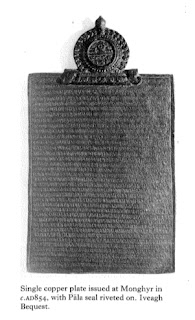[Make sure you read the UPDATE below] First of all, a small rant. Why can we not have something like
this for Sanskrit manuscripts? Hats off to Prof. Witkam, especially since he scanned this book as well:
The Art of the Book in India (you will have to scroll down the list to 'Jeremiah P. Losty'). The introduction of this very nice publication has a few things to say about copper plates as well and it is there that we find the image on the left of this text on p. 11. The caption reads: "Single copper plate issued at Monghyr in c. AD 854, with Pāla seal riveted on. Iveagh Bequest."
Get the book if you want to read some of the text, this image is not very good. On and off some
akṣaras are legible on the paper version. For now you will have to believe me that the seal reads
śrīdevapāladevasya. Yes, this seems to be the Monghyr copper plate of Devapāla, "the first Sanskrit inscription that was ever brought to the notice of European scholars" as Kielhorn says (Indian Antiquary, September 1892, p. 253 ff.). This issue of the IA is
available at DLI, you can check the references given there for the
first publication and other studies.
What is interesting here is that as of 1892 the plate got lost (again paraphrasing Kielhorn here, perhaps the plate was lost even earlier). Apparently it somehow made it into the Iveagh collection, where it was photographed by Losty. Why on earth would this collection of paintings (famous Rembrandts included) and other things have the Munghyr copper plate, I have no idea. But it seems to be there, just a few dozen miles away from me, at a place called
Kenwood House in Hampstead. Stay tuned for more.
Meanwhile, to modestly celebrate the resurfacing (at least for me) of this inscription, here is one of my favourite verses from the edict:
bhrāmyadbhir vijayakrameṇa karibhiḥ svām eva Vindhyāṭavīm
uddāmaplavamānabāṣpapayaso dṛṣṭāḥ punar bāndhavāḥ |
Kambojeṣu ca yasya vājiyuvabhir dhvastānyarājaujaso
heṣāmiśritahāriheṣitaravāḥ kāntāś ciraṃ vīkṣitāḥ ||
And here is Kielhorn's translation (1892):
"In the course of conquest his elephants, roaming over their own Vindhya forest, met again with their kindred who shed plentiful tears (of joy); and, after he had crushed the power of other kings, his young chargers in Kamboja at last saw their mates, and it was a pleasure to hear them loudly neigh at each other."
And that of Wilkins (Esq.) (1799):
"He who, marching through many countries making conquests, arrived with his elephants in the forests of the mountains of Beendhya, where seeing again their long lost families, they mixed their mutual tears; and who going to subdue other princes, his young horses meeting their females at Komboge, they mutually neighed for joy."
Crying elephants: that sounds
familiar.
UPDATE: Ok, forget about the whole thing. The plate was known to have resurfaced, cf.
Bhandarkar's list and
EI XVIII, pp. 304 f. and Pl.







